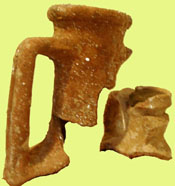|
Pozzuoli
Caligula's Bridge. There is plenty of debate among
scholars and archaeologists concerning the existence of "Caligula's
Folly." According to some it was Caligula's brainstorm:
a causeway formed by mooring unused transport ships together
in rows of twos from the ancient Greek port jetty at Pozzuoli.
The ships were filled with stone and sunk in place. Thusly, a
solid span was created. The opposite end was Bauli near
Baia. According to story, Caligula galloped across the bridge
on his horse and hosted wild parties on the bridge that lasted
for days.
Depths along the theoretical route range from 10 to 30 feet.
Greek remnants of the ancient original port were covered over
with stones in recent times to make for a larger, sturdier wharf
foundation.
The only visible evidence of the structure's existence was
the finding of ornate clay oil lamps in great numbers that would've
lighted the causeway at night. Thousands have been recovered
but many more remain scattered along the bottom of the bay at
Portus Julius.
Greek-Roman Port
Greek-Roman Port. Along the edge of the promontory
facing the open gulf. Remains are mostly square column pillars
8 to 10 feet high that supported the ancient Pozzuoli docking
area. Depths range from 15 to 20 feet.
Ancient debris and shards lie scattered between the pillars that
cover an area of about 500 yards. The wharf followed the waterfront
from the original promontory to the Temple of Serapide.


|